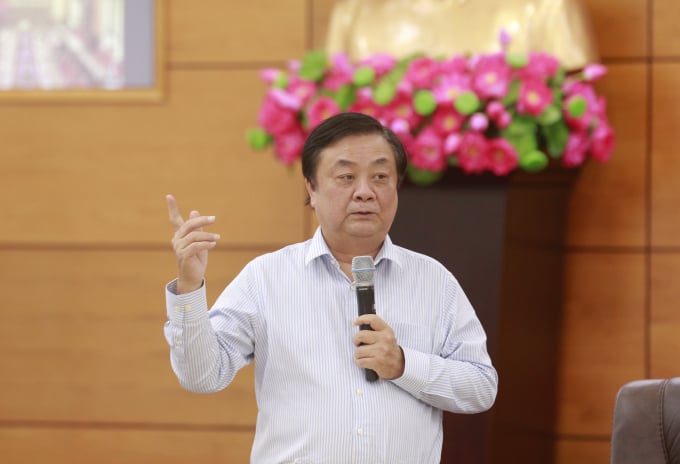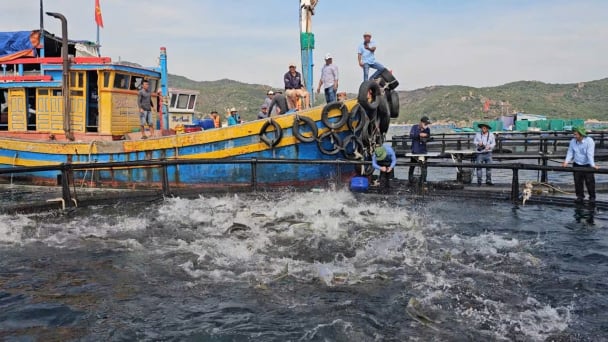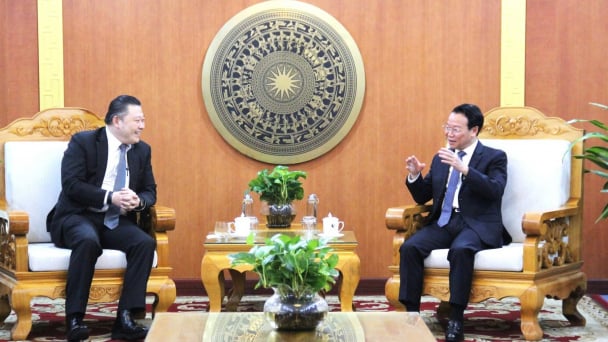May 21, 2025 | 02:43 GMT +7
May 21, 2025 | 02:43 GMT +7
Hotline: 0913.378.918
May 21, 2025 | 02:43 GMT +7
Hotline: 0913.378.918

Minister of Agriculture and Rural Development Le Minh Hoan speaks at the meeting with Lao Cai province leaders. Photo: M.D.
The northern province of Lao Cai currently can maintain agricultural security, promote the development of agricultural commodities, change the mindset on agricultural production to agricultural economic development.
The province focuses on developing six key commodity industries and five breakthroughs to implement Resolution No. 10 of the Standing Provincial Party Committee on the strategy for the development of commodity agriculture in Lao Cai province to 2030, with a vision to 2050. Accordingly, six key commodities are promoted including tea, medicinal herbs, bananas, pineapples, cinnamon, and pig farming.
Five breakthrough contents are the conversion of plant and animal varieties; converting inefficient cropland to valuable crops; promote various types of production organisations and services associated with processing and production linkages; implement land allocation, forest allocation for forestry economic development; innovate management methods for the development of agricultural production in the new situation.
Lao Cai's agriculture is developing in the direction of multi-value, linking agricultural production development with tourism. The agricultural production value in 2021 was estimated at over VND8.6 trillion with the growth rate reaching 5.7 per cent, product value over an unit of cultivation was estimated at VND85 million, an increase of 6.1 per cent compared to 2020.
Lao Cai also exploited and promoted the potential and strengths of each locality to develop agroforestry production and safe production.
Secretary of the Lao Cai Provincial Party Committee Dang Xuan Phong said that the agricultural sector of Lao Cai clearly played a role as the backbone of the provincial economy, but that was not enough.
Lao Cai proposed that the Ministry of Agriculture and Rural Development continue to pay attention to and support Lao Cai province with a number of contents related to institutions and general policies in agricultural and rural development; support development and production of varieties (medicinal materials, plant varieties, indigenous livestock); processing, trade promotion, investment, and building a logistics centre in the province.
It also called for support to the construction of models of community-based tourism development associated with building new rural areas, building model villages and hamlets in border areas.

Minister Le Minh Hoan talks to pineapple farmers in Muong Khuong district. Photo: M.D.
Additionally, it proposed the ministry summarise and submit to the Government to balance and allocate funds for Lao Cai province to implement forest protection and development, pilot the sale of carbon credits, and create resources to keep forests; provide financial support to implement agricultural development models, invest in the construction of rural infrastructure works, especially the Red River embankment.
Minister Le Minh Hoan recommended that Lao Cai need to develop a local branding - the image of Lao Cai. Lao Cai has many difficulties, but in return, it also has its own development potential.
The province must have a different approach, instead of following the old one.
“When resources are limited, creativity is a key for development, for examples, developing OCOP products, product diversification, changing market approach, shifting agricultural production from an production industry to agricultural economy, increasing added value at all stages,” he said.
Lao Cai needs to reorganise production, develop economic cooperation, harmoniously share benefits; and call for investment in rural economic areas.
The province was also suggested to standardise production to meet market requirements.
Training is also needed to update knowledge on technique and market developments. Agricultural start-up clubs should be opened. The agricultural and rural development strategy must help reduce costs, increase quality, and optimize prices.
The province needs to focus on rural economy such as cooperatives, small and medium enterprises, even micro ones, forming rural economic ecosystem. In addition, Lao Cai also needs to transform the new rural model into a new rural model associated with rural economic development, with the focus on cooperative economy and OCOP products.
Translated by Hien Anh

(VAN) Khanh Hoa is investing over 545 billion VND to develop 240 hectares of high-tech marine aquaculture in order to guarantee a consistent supply of seafood exports and achieve the USD 1 billion target.

(VAN) Minister of Agriculture and Environment Do Duc Duy held a meeting with Soopakij Chearavanont, Chairman of C.P. Group, on May 15.
/2025/05/16/3800-0-nongnghiep-143756.jpg)
(VAN) Suntory PepsiCo Vietnam coordinated with the Ministry of Education and Training to implement an education program on water conservation, reaching nearly 1 million primary school students nationwide.

(VAN) Vietnam’s TH Group officially put its high-tech fresh milk processing plant into operation in the Russian Federation, marking a historic moment as the first TH true MILK cartons were produced in Russia.

(VAN) Use of high-quality broodstock and biotechnology is regarded as the most effective approach to ensuring sustainable and economically viable shrimp aquaculture ahead of climate change and the emergence of increasingly intricate disease patterns.

(VAN) Carbon farming is a form of agricultural practices that helps absorb more greenhouse gases than it emits, through smart management of soil, crops, and livestock.

(VAN) This is a key content of the Memorandum of Understanding recently signed between the Vietnam Fisheries Society and Kunihiro Inc of Japan.